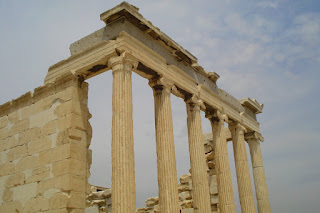One of the best ways to see Naxos is to take the 'round the island' tour by bus. It's a large, mountainous island and the scenery is spectacular. I wanted to post some here but most of my scenic views are on a movie I took. Along the way you stop at various villages and some sites that have been abandoned over time like this ancient church where, during the Turkish occupation of the 1400's, there was a 'secret school' where the Greek children were taught their own language and history (which had been forbidden by the Turks).
There are some abandoned villages on Naxos. Many were abandoned due to pirate raids. The tour guide explained that children of Turkish/Greek parentage were neither accepted as Muslim or Orthodox and a great many of them turned to piracy. On my earlier trips to Naxos I got caught up in this feeling of 'abandonment', also relating it to Ariadne having been abandoned by Theseus on this island. This time I didn't have quite the same feeling as there seems to be more activity in these remote villages, although we were told that the young people are are leaving for the city so in fact, soon they might become 'abandoned'.
This is the little port of Apollonas which is apparantly very popular with people from Athens as a summer resort. The beach here isn't very appealing and at the other side are rocks with surf pounding in from the sea. But there's lots of fishing boats and some nice fish tavernas along the shore.
You'll find a number of interesting archaeological sites on the island. This ancient marble quarry is walking distance from Appolonas. Here is a gigantic abandoned Kouros statue which apparantly had cracked when the sculptor was working on it. There's a couple of these abandoned kouros on the island.
This one is dated to the 7th century BC. It's 10.5 meters in length and who know how much tonnage?
Naxos is one of those islands I know I'll return to several times. There's lots to see and do there besides lying around the beach. It's an agriculturally rich island famous for it's potato crops, vineyards, olive groves, figs and citrus. Only on Naxos do they make the liquer called "Kitron" from the leaves of a tree much like a lemon tree which was first introduced to the Mediterranean in about 300 BC. The ancient Greeks called it the Median apple, and apparantly it was Alexander the Great who first sent it back to Greece, no doubt along with other botanical treasures he'd sent his old teacher Aristotle.



